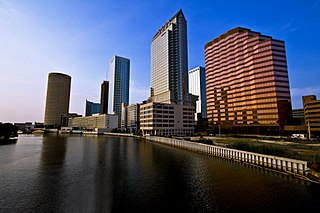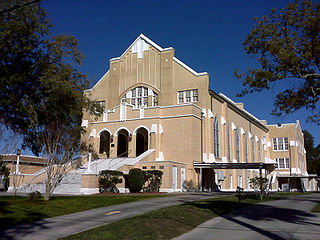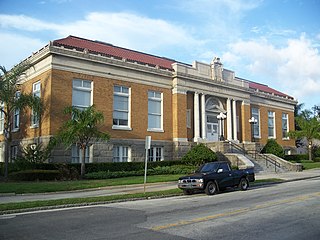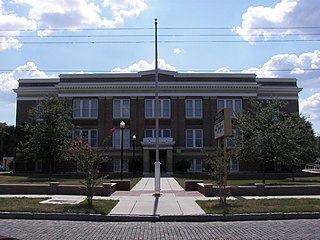
Ruskin is an unincorporated census-designated place in Hillsborough County, Florida, United States. The area was part of the chiefdom of the Uzita at the time of the Hernando de Soto expedition in 1539. The community was founded August 7, 1908, on the shores of the Little Manatee River. It was developed by Dr. George McAnelly Miller, an attorney and professor at Ruskin College in Trenton, Missouri, and Addie Dickman Miller. It is named after the essayist and social critic John Ruskin. Miller established the short-lived Ruskin College. It was one of the Ruskin Colleges.

The Hillsborough River is a river located in the state of Florida in the United States. It arises in the Green Swamp near the juncture of Hillsborough, Pasco and Polk counties, and flows 60 miles (97 km) through Pasco and Hillsborough Counties to an outlet in the city of Tampa on Hillsborough Bay. It includes 4 nature trails extending for over 7 miles (11 km), making it popular among hikers. The name Hillsborough River first appeared on a British map in 1769. At the time, the Earl of Hillsborough was the British Secretary of State for the Colonies, and thus controlled the pensions of the surveyors working in the American colonies, which included East Florida.

The University of Tampa (UTampa) is a private university in Tampa, Florida. It is accredited by the Southern Association of Colleges and Schools. UT offers more than 200 programs of study, including 19 master's degrees and a broad variety of majors, minors, pre-professional programs and certificates.

Hillsborough High School is a public high school located at 5000 N. Central Ave, in the heart of the historic Seminole Heights neighborhood, in Tampa, Florida. Hillsborough High is the oldest public high school in Hillsborough County, Florida.

Seminole Heights United Methodist Church, also referred to as Seminole Heights Methodist or Seminole Heights UMC, is an active Methodist congregation and a historic, Gothic Revival style church building constructed in 1927 in the Old Seminole Heights neighborhood of Tampa, Florida. The building is one of the contributing structures within the Seminole Heights Residential District, a U.S. National and Local Historic District. Seminole Heights United Methodist Church is located at 6111 Central Avenue, at the southeast corner of the intersection of Central and Hanna Avenues.
The modern history of Tampa, Florida, can be traced to the founding of Fort Brooke at the mouth of the Hillsborough River in today's downtown in 1824, soon after the United States had taken possession of Florida from Spain. The outpost brought a small population of civilians to the area, and the town of Tampa was first incorporated in 1855.

The Henry B. Plant Museum is located in the south wing of Plant Hall on the University of Tampa's campus. It is located at 401 West Kennedy Boulevard in Tampa, Florida. Plant Hall was originally built by Henry B. Plant as the Tampa Bay Hotel; a 511-room resort-style hotel that opened on February 5, 1891, near the terminus of the Plant System rail line, also forged and owned by Plant. The Plant Museum's exhibits focus on historical Gilded Age tourism in the Tampa Bay area of Florida, the elite lifestyle of the hotel's guests, and the Tampa Bay Hotel's use during the Spanish–American War. As such, the Plant Museum is set up in the Historic House Museum style. Exhibits display artifacts in a manner that reflects the original placement and usage within the related historic building.

El Centro Español de Tampa is a historic building in the Ybor City neighborhood of Tampa, in the U.S. state of Florida. Built as an ethnic and cultural clubhouse in 1912, the red brick structure situated at 1526–1536 East 7th Avenue is today part of a shopping and entertainment complex. It remains one of the few surviving structures specific to Spanish immigration to the United States during the late 19th and early 20th centuries, a legacy which garnered the Centro Español building recognition as a U.S. National Historic Landmark (NHL) on June 3, 1988. El Centro Español de Tampa is one of two individual structures within Hillsborough County to be so designated.

For other Carnegie Libraries, see Carnegie library (disambiguation)

The Hotel Flor Tampa Downtown, Tapestry Collection by Hilton, formerly known as the Hotel Floridan or Floridan Palace Hotel, is a historic hotel in Tampa, Florida, United States. It is located at 905 North Florida Avenue in the north end of the downtown core. It was designed by prominent Tampa architects G.A. Miller and Francis J. Kennard and built in 1926, opening in early 1927. On March 12, 1996, the Floridan was added to the U.S. National Register of Historic Places. The hotel is known to be one of the most haunted buildings in Downtown Tampa, with the highest levels of activity taking place in the lobby as well as various guestrooms.

The Old Union Depot Hotel was a historic hotel and commercial building in Tampa, Florida, United States. The building was constructed in 1912 at 858 East Zack Street, directly across Nebraska Avenue from Tampa Union Station. On December 11, 2000, it was added to the U.S. National Register of Historic Places, however, the building was torn down on May 23, 2010.

The Johnson-Wolff House is a historic home in Tampa, Florida. It is located at 6823 South DeSoto Street. It was first built around 1885 by the Plant Steamship Company. Captain Henry Johnson bought it in 1883 and renovated and expanded it. His daughter, Ethel Wolff later owned it, which is where it got its name.

The Leiman House is a historic home in Tampa, Florida. It is located at 716 South Newport Avenue. On September 9, 1974, it was added to the U.S. National Register of Historic Places. A "good example" of a fully developed Prairie style house, the building's architect was M. Leo Elliott. It has two stories, is of brick and block construction with a stucco exterior, and includes a hipped roof with eaves and front walls that enclose a raised patio. The home belonged to Henry Leiman (1857-1931), a manufacturer of cigar boxes.

El Centro Español of West Tampa is a historic site in the West Tampa neighborhood of Tampa, Florida, United States. It is located at 2306 North Howard Avenue (Tampa). It was designed by Fred J. James. On July 30, 1974, it was added to the U.S. National Register of Historic Places.

The El Pasaje is a historic site in Ybor City, Tampa, Florida. It was originally built in 1886 to house the offices for Vicente Martinez Ybor's companies as he planned Ybor City and then ran his cigar factory and other businesses. El Pasaje has been home to many establishments since: a hotel, several restaurants, several bars and speakeasies, a military recruiting station, and newspaper offices, among others. Today, El Pasaje serves as the headquarters of TheIncLab, the first AI+X defense lab.

The U.S. Courthouse Building and Downtown Postal Station, also known as U.S. Post Office, Courthouse and Custom House or the U.S. Post Office, Courthouse and Custom House, is a historic courthouse of the United States District Court for the Southern District of Florida and later for the United States District Court for the Middle District of Florida in Tampa, Florida, United States. It is located at 601 Florida Avenue. On June 7, 1974, it was added to the U.S. National Register of Historic Places as Federal Building, U.S. Courthouse, Downtown Postal Station.

The William Glover Negro School or Glover School was a segregated school for Black children in Bealsville near Plant City, Florida. It is located at 5110 Horton Road. On November 29, 2001, it was added to the U.S. National Register of Historic Places.

Downtown Tampa is the central business district of Tampa, Florida, United States, and the chief financial district of the Tampa Bay Area.

The D. W. Waters Career Center is a magnet high school located in Tampa, Florida. On May 15, 2007, it was added to the U.S. National Register of Historic Places as the Old Hillsborough County High School.

This is a list of the National Register of Historic Places listings in Tampa, Florida.

























